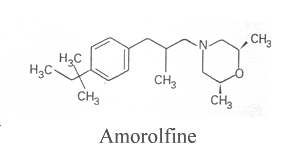Trade & Generic Names & General Features
Amorolfine is a morpholine derivative which is used topically as an antifungal agent. It has a broad spectrum of activity, including dermatophytes, various filamentous and dematiaceous fungi, yeasts and dimorphic fungi. Its activity is fungicidal for most species [451, 984, 1818]. It penetrates into the nail rapidly and achieves concentrations higher than the MICs obtained for most of the fungi causing onychomycosis. [1002, 1817, 2246]. Its clearance is slow following topical application [1962]. Amorolfine has been ineffective when administered orally to animals with systemic fungal infections. This lack of activity may be due to protein binding and/or rapid metabolism of the drug [1818, 1890].
Amorolfine has 5% nail lacquer formulation. It is being manufactured by Roche Laboratories and its trade name is Loceryl™.
The most significant advantage of nail lacquer formulation is that it builds a non-water soluble film on the nail plate which remains at the application site for a week. This film acts as a depot for the drug [1809]. Cream, vaginal tablet and spray formulations of amorolfine were once available but no longer appear to be manufactured.

Mechanism(s) of Action
Amorolfine blocks delta 14 reduction and delta 7-8 isomerisation, resulting in depletion of ergosterol and accumulation of ignosterol in fungal cytoplasmic membrane. Fungal cell wall becomes thicker and chitin deposits are formed inside and ouside the cell wall [1818].
Susceptibility Patterns
Amorolfine exerts fungicidal activity on dermatophytes. It is also active against other filamentous fungi that cause onychomycosis, such as Scytalidium spp. and Scopulariopsis spp. [451]. It yields relatively low MICs also for various dematiaceous fungi [1682]. Its in vitro spectrum appears broad when tested against various fungi [541]. However, in vitro susceptibility testing parameters for amorolfine remain yet variable, due to the lack of a standard methodology for testing dermatophytes and data reported so far are limited [541].
For amorolfine MICs, see susceptibility patterns and the N/A(L):susceptibility database.
Usual Doses
Amorolfine 5% nail lacquer is applied once or twice weekly for up to 6 months in onychomycosis [1302, 1890].
In various superficial dermatomycoses, amorolfine cream has previously been used once daily on the infected area for up to 6 weeks [984].
Side-Effects
Topical amorolfine is well-tolerated and minor local adverse reactions are observed rarely. Burning sensation, dryness of skin, scaling, itching, erythema and weeping have been reported [553, 984, 1651, 1652].
Routes
Amorolfine is available for topical administration in 5% nail lacquer formulation.
Current Status
The most significant indication for amorolfine treatment is mild onychomycosis without nail matrix involvement [613]. While amorolfine achieves clinical cure in around 40 to 55% of patients with mild onychomycosis, those with severe onychomycosis involving the nail bed require systemic treatment [984, 1005].
Amorolfine appeared effective also in treatment of various superficial dermatomycosis [553, 554, 984, 1652]. Its activity in dermatomycosis appeared similar to that of topical bifonazole in terms of clinical and mycological cure rates [551]. Also, single dose treatment of vulvovaginal candidiasis with 50 mg or 100 mg of amorolfine vaginal tablets yielded favorable activity, except in cases due to Candida glabrata [557]. However, cream and vaginal tablet formulations of amorolfine are not available anymore.
The role of topical amorolfine in combination with a systemic antifungal agent has not been fully defined. However, amorolfine appears synergistic with ketoconazole, griseofulvin, and terbinafine in vitro. Moreover, in a murine model of dermatophytosis, amorolfine combined with griseofulvin, terbinafine, itraconazole or fluconazole appeared more active than monotherapy with any of the agents [1816].
